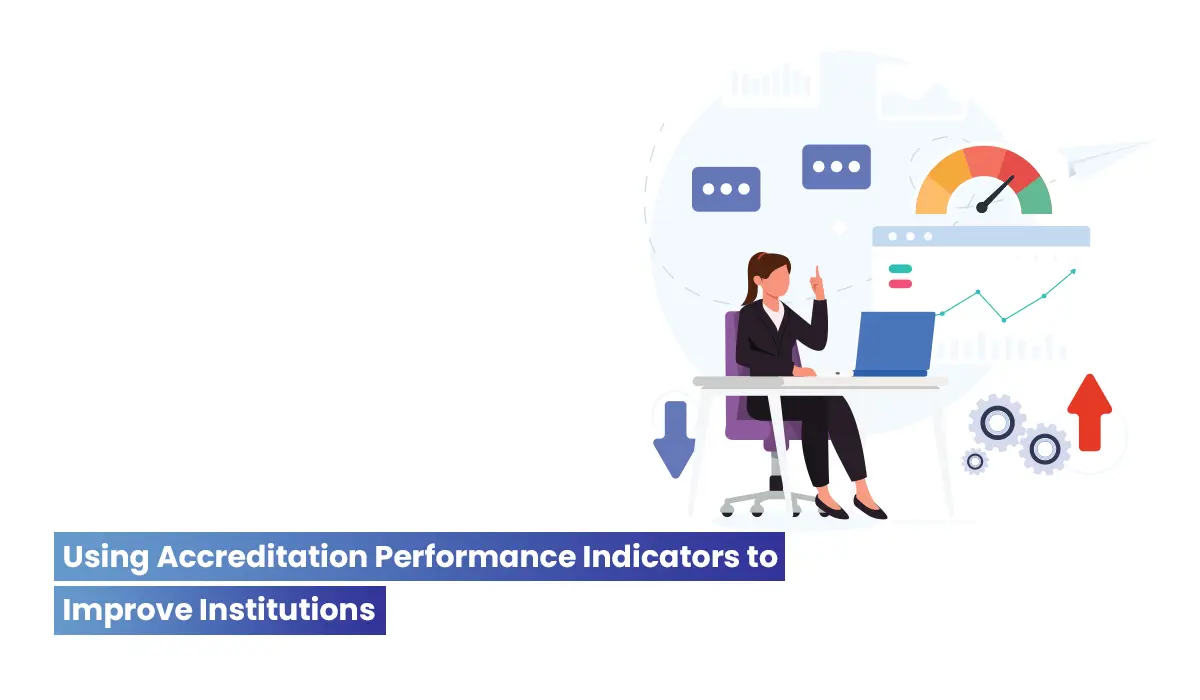A Guide to the Accreditation Process with the National Commission for Academic Accreditation and Assessment (NCAAA)
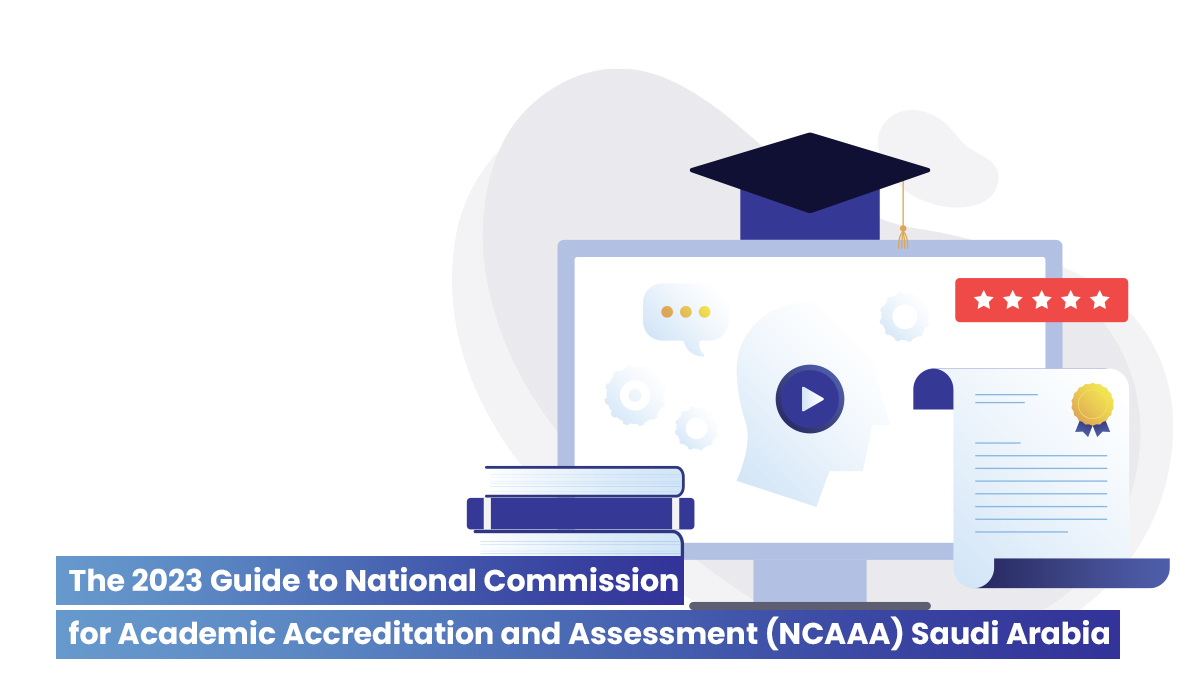
Overview of NCAAA Saudi Arabia
The 2030 vision for Saudi Arabia is causing a rapid change in the country's higher education standards. There is a greater emphasis on value education everywhere. The Ministry of Education (MOE) advises universities to apply for institutional and program accreditation through the National Commission for Academic Accreditation and Assessment (NCAAA), an independent organization that answers directly to the Council of Higher Education.
The National Commission for Academic Accreditation and Assessment (NCAAA) is now one of the critical players in the higher education landscape, responsible for ensuring that academic programs offered by institutions meet standards of quality and
rigor. We will explore a lot about NCAAA in this guide. We propose to provide a comprehensive overview of the accreditation process and help institutions prepare for accreditation in this post.
The role of quality assurance in Saudi’s Higher Education
The National Commission for Academic Accreditation and Assessment was created as a result of the rapid expansion of Saudi Arabia's higher education institutions, which increased the need for quality assurance.
In 2016, the Saudi government invested a sum equal to one-third of its total national Gross Domestic Product (GDP) in the field of education after considering funding for high-quality HE practices for years. The goal of this initiative was to advance Saudi Arabia's knowledge-based economy as part of the nation's ambitious "Vision 2030" reforms.
The National Commission for Academic Accreditation and Assessment (NCAAA) was a result of Saudi Arabia’s push to create a system to assess the quality of higher education and to deal with the growth of higher education institutions.
The NCAAA Saudi Arabia role is active in the region and offers several services including
Accreditation of institutions Accreditation of the programs Standards and requirements for pursuing international accreditations
- Accreditation of institutions
- Accreditation of the programs
- Standards and requirements for pursuing international accreditations
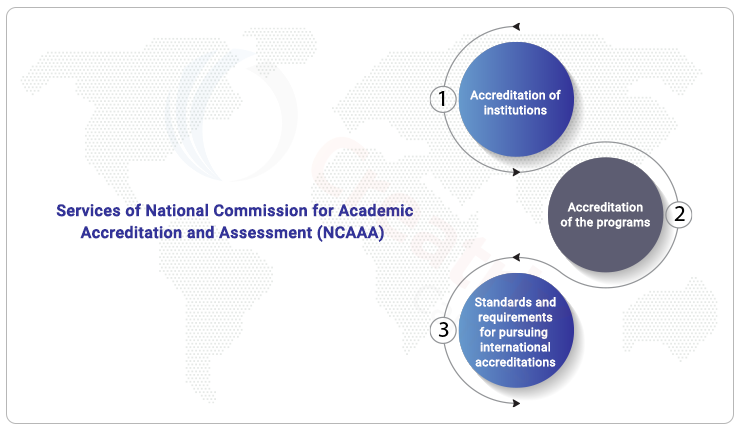
The history of the NCAAA Saudi Arabia
The NCAAA was founded in 2004 and was initially overseen by the Ministry of Higher Education. However, since 2018, it has been under the Education Evaluation Commission, which was established by Royal Decree in that year.
The Commission is in charge of Saudi universities, and its main goals are to improve the quality of educational outcomes, the proficiency of universities, and their contribution to the development of the economy.
The NCAAA was established in response to growing concerns about the quality of education being offered by some institutions and the need for a more comprehensive evaluation system. It was borne out of the collaborative effort between educational leaders, government officials, and members of the business community.
The organization was founded with the goal of creating a comprehensive evaluation system that would assess the quality of educational programs offered by institutions of higher learning and provide a basis for continuous improvement.
Since its founding, the NCAAA has grown and evolved, becoming a leading organization in the field of higher education accreditation. Over the years, the NCAAA has developed a robust evaluation process that takes into account a wide range of factors, including the institution's mission and goals, its programs, its students, and its resources.
What is National Commission for Academic Accreditation and Assessment (NCAAA)?
The National Commission for Academic Accreditation and Assessment (NCAAA) is a governmental organization in Saudi Arabia responsible for ensuring the quality of higher education in the country. Its purpose is to evaluate and accredit academic programs and institutions of higher education and to provide recommendations for their improvement.
The NCAAA serves as a quality assurance mechanism that validates the credibility and effectiveness of academic programs offered by institutions of higher learning. It helps to ensure that students receive a high-quality education that prepares them for careers and life. The accreditation process involves several stages, including self-evaluation, site visits, and follow-up, which will be discussed in later sections.
Importance of NCAAA Accreditation

Accreditation by the National Commission for Academic Accreditation and Assessment (NCAAA) is important for several reasons including;
Quality assurance: NCAAA accreditation ensures that academic programs and institutions meet certain standards of quality and provide a high-quality education to students. Recognition: Accreditation by the NCAAA provides recognition and credibility to academic programs and institutions, which can increase their reputation and competitiveness.
Student benefits: Accreditation by the NCAAA provides assurance to students and their families that the education they receive is of high quality and meets certain standards. This can increase student satisfaction and help them achieve their academic and career goals.
Improved NCAAA standards: Accreditation by the NCAAA encourages academic programs and institutions to continuously improve their standards and practices, which can lead to better outcomes for students and the wider community.
NCAAA standards and program accreditation eligibility requirements
NCAAA committee has well-stated eligibility requirements that the institutions should satisfy, backed up by data. It is crucial to remember that the NCAAA requires transparency and clarity in everything that is submitted.
To get accredited by the NCAAA, a higher education institution or program must meet certain standards and criteria set by the commission. The summary of the 13 requirements is listed below.
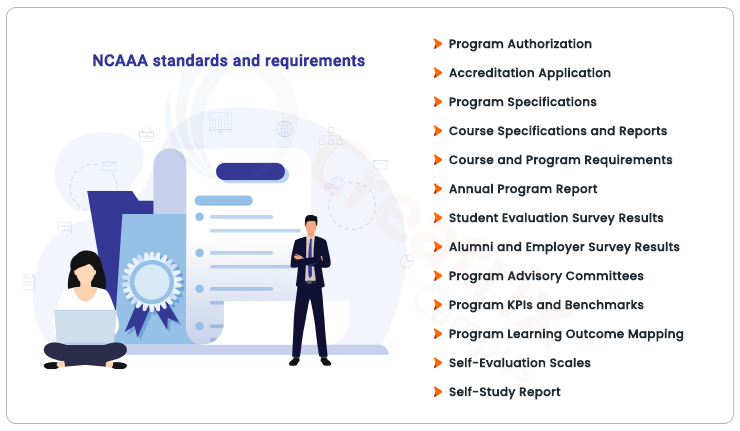
1. Program Authorization: The program must be approved for the Institution to offer by the appropriate government agency.
2. Accreditation Application: The institution and the NCAAA must come to an agreement stating that the program qualifies for application.
3. Program Specifications: The program coordinator must submit this document using the NCAAA template. This document should outline the program's mission and vision, as well as the learning objectives, instructional strategies, and evaluation criteria. The department board or program steering committee must approve this document.
4. Course Specifications and Reports: This document contains course descriptions, topics, learning objectives, teaching and assessment strategies, and other crucial course-related information like textbooks and references are submitted. Course reports cover everything concerning students, evaluations of teaching strategies and learning outcomes, and a course action plan for the following year.
5. Course and Program Requirements: This includes every detail about the program, department, faculty, and institution regulations and policies.
6. Annual Program Report: This is similar to the course report, but it analyses the outcomes of the entire course, teaching methods, assessment techniques, an action plan, and problems with the program's course delivery for the academic year.
7. Student Evaluation Survey Results: All courses must have had student evaluation surveys that had a minimum response rate of 50%. By the time the Self-Study Report for Programs (SSRP) is finished with an action plan, summary reports on survey responses must be accessible for at least two years.
8. Alumni and Employer Survey Results: The program must have at least one completed cohort, and feedback from that cohort must be available. There should also be an employer survey.
9. Program Advisory Committees: A Program, Department, or College Advisory Committee must be established for any program designed to prepare students for professional practice, with a majority of members in the profession(s) concerned who are external to the institution.
10. Program KPIs and Benchmarks: KPIs must have been chosen from the NCAAA proposed KPIs for benchmarking the program's quality. A list of KPIs used, along with benchmarks and analysis, must be available.
11. Program Learning Outcome Mapping: Mapping the course learning outcomes with the program learning outcomes to ensure consistency.
12. Self-Evaluation Scales: The Self-Evaluation Scales for Higher Education Programs must have been completed with a rating of at least three stars on all NCAAA standards and sub-standards applicable to the program.
13. Self-Study Report: An initial version of the SSRP is required.
NCAAA steps for institutional accreditation with tips for HEIs
Through academic evaluation and accreditation, NCAAA seeks to improve the quality and excellence of higher education programs and institutions. It, therefore, tries to enhance and streamline the accreditation process, including the identification and simplification of the review process and procedures, in order to make the accreditation process and procedures practical and efficient.
The detailed breakdown of the NACCC accreditation process is shown in the image below.

Found below are the steps to institutional accreditation.
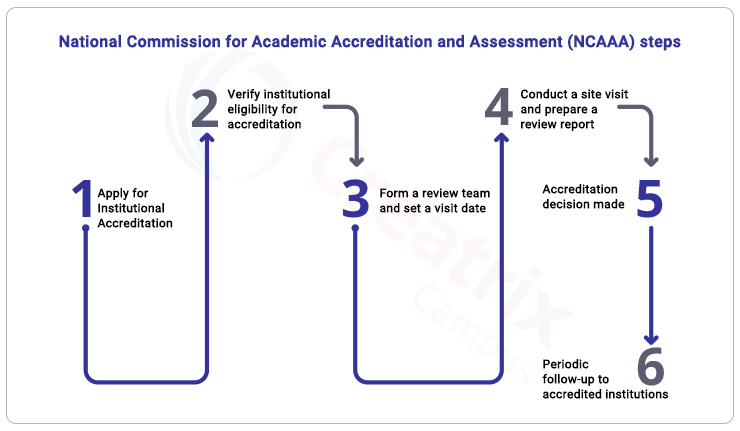
Application request and training
The first step by the institution is to apply for accreditation by contacting the NCAAA through the institution, typically through the Deanship of Quality and Academic Accreditation (DQAA). The DQAA verifies the program's eligibility by reviewing its documents and evidence to ensure that NCAAA standards are met.
The NCAAA provides up to two training workshops for program administrators based on their needs and required areas of inquiry. The topics are chosen based on the needs of the program.
Preparation for NCAAA: Before starting the accreditation process, it is important to review the NCAAA's latest standards and guidelines. This will ensure that you have a clear understanding of what is required and can prepare accordingly.
Familiarize yourself with NCAAA standards and guidelines and the “big 6”.
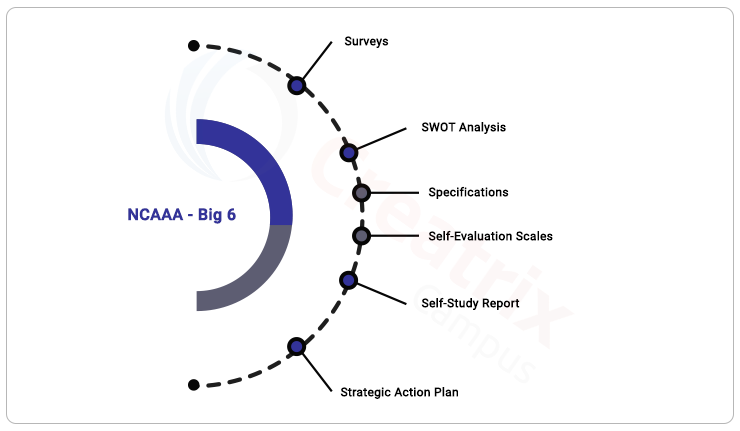
Self-study report: A self-study report is nothing, but a process combining - Description --- Analysis --- Evidence --- Reflection ---- Action.

To prepare for the accreditation process, you will need to gather a range of documents and data.
The self-study form is broken down into three major sections: Institution profile, which includes resources and facilities; Institution's self-study process, which includes key performance indicators, or KPI; and Analysis of KPI outcomes, which highlights strengths and weaknesses. You will also need to provide evidence that you are meeting the NCAAA's standards and guidelines.

Assemble the accreditation team and ensure their availability for the accreditation visit:
An accreditation team is responsible for preparing the self-evaluation report (SER) and representing the institution during the accreditation site visit. This team should include key staff members from different departments, including administration, academic affairs, and student services. It is important to ensure that the team members are available for the accreditation visit.
Verifying institutional eligibility with Self-Evaluation Report (SER)
The self-evaluation report (SER) is a document that provides an in-depth analysis of the institution's programs and their compliance with NCAAA standards and guidelines. The SER serves as the basis for the accreditation site visit and is used to determine if the institution meets the NCAAA's standards for accreditation.
You will have to send the following basic paperwork to the NCAAA:
- Self-study reports and scales for self-evaluation
- Statistical data Program-related files (specification and report)
- Key Performance Indicators
- Results of three questionnaires: learning experiences questionnaire, course questionnaire, and questionnaire for program evaluation. Other types of questionnaires, like ones for graduates' and students' learning experiences, can also be made available by the program.
Note: The NCAAA registers the documents as soon as they are received and gives them to the qualified deputy. The documents will be examined by a consultant to ensure that they are complete and confirm that the program qualifies for accreditation.
Preparation for SER: The SER should be well-organized and provide a comprehensive analysis of the institution's programs, including their strengths and areas for improvement. The SER should include information about the institution's mission, goals, and objectives, as well as its programs, students, and resources.
Submitting the SER to NCAAA: Once the SER is complete, it should be submitted to the NCAAA for review. The NCAAA will use the SER to determine if the institution is ready for an accreditation site visit.
Form a review team and decide on a visit date
For NCAAA specialists to visit the institution and program, you will have to schedule an appointment. This happens by the review team which decides on the visit date. Generally, the program audit teams are chosen by the Accreditation Coordinating Committee, and the Auditors Unit coordinates with the auditors and sends invitations. The program review's logistics are handled entirely by the NCAAA.
NCAAA Accreditation site visits
The actual review of the program takes place during the site visit. According to the scope of the program, two or three reviewers are assigned and they take around two to three days to complete. A member of the NCAAA accreditation team and a public relations representative from the organization are typically present to manage logistics and oversee the review procedure, respectively.
The reviewers submit their reports to the NCAAA along with a thorough visit report, a standards compliance table, and evaluation metrics that allow them to quantify each review, add to the evaluation of the program, aid in comparisons, and extract various statistical data and reports.
The consultation team examines the auditors' reports for coherence and veracity, then recommends to the Executive Director whether to announce rejection, conditional accreditation, or full accreditation.
Accreditation decision and review
The accreditation site visit is an on-site evaluation of the institution's programs by a team of NCAAA evaluators. The purpose of the site visit is to validate the information provided in the SER and determine if the institution meets the NCAAA's standards for accreditation.
Evaluation report: The evaluators will prepare a report summarizing their findings and make recommendations for improvement.
Decision-making: The NCAAA will review the evaluation report and make a decision on the institution's accreditation status, which may be initial accreditation, reaccreditation, or denial of accreditation.
Follow-up: The institution may be required to submit follow-up reports or participate in further site visits to demonstrate compliance with accreditation standards.
Preparation for NCAAA site visit: To prepare for the accreditation site visit, the institution should be ready to provide additional information and documentation to support the information provided in the SER.
Monitoring and maintenance of accreditation
NCAAA quality planning and review cycle: After obtaining the National Commission for Academic Accreditation and Assessment (NCAAA), institutions should be under the quality planning and review cycle customarily. This includes regularly reviewing and updating its criteria and standards, conducting evaluations of institutions and programs, and making decisions on accreditation status. The steps of the same are graphically shown below.

To ensure the integrity of its accreditation process, the NCAAA has established various internal mechanisms and procedures, such as internal and external quality assurance reviews, regular assessments of its own operations, and an appeals process for institutions and programs that are dissatisfied with the accreditation decisions.
In addition, the NCAAA is subject to oversight by the Ministry of Education in Saudi Arabia, which has the authority to review and approve its policies and procedures and to ensure that it is operating in accordance with applicable laws and regulations.
National Commission for Academic Accreditation and Assessment's Estimated Time of Completion
The NCAAA accreditation timeline is from 3 months to two years time. The breakup is graphically shown below.
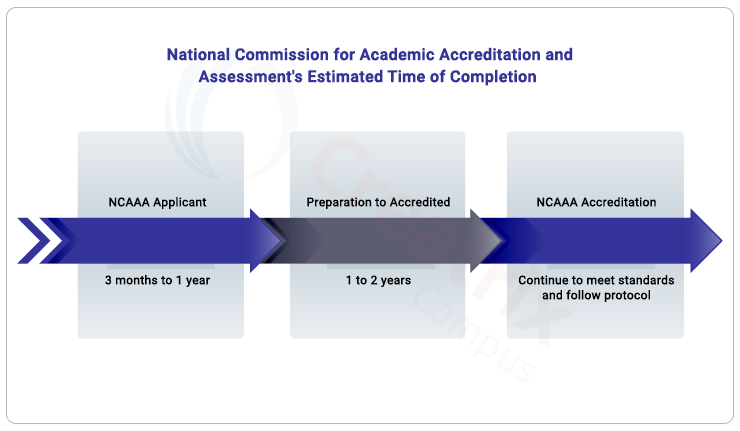
Criticisms surrounding the NCAAA
The National Commission for Academic Accreditation and Assessment (NCAAA) has received several criticisms but these only highlight the challenges faced by accreditation bodies in ensuring a fair and transparent accreditation process.
Some criticisms of them are,
Lack of transparency: The NCAAA has been criticized for its lack of transparency in its decision-making process, particularly in regard to the criteria used to accredit institutions and programs.
Rigid criteria: Some have argued that the NCAAA's criteria for accreditation are too rigid and don't take into account the unique needs and circumstances of individual institutions and programs.
Inadequate assessment: Some have criticized the NCAAA's assessment methods as inadequate, arguing that they do not accurately reflect the quality of academic programs and institutions.
Conflicts of interest: There have been concerns raised about potential conflicts of interest within the NCAAA, particularly with regard to the involvement of institutions in the accreditation process.
In terms of alternative approaches to accreditation, some have called for a more decentralized and participatory approach, in which institutions and programs are involved in the accreditation process and are given greater autonomy in determining their own criteria and methods for assessment.
In spite of its criticisms, the NCAAA has also expanded its reach, working with institutions of higher learning from all over the world to ensure that they meet its high standards for accreditation. Through its efforts, the NCAAA has helped to improve the quality of higher education and prepare students for successful careers and lives.
Challenges institutions encounter during the NCAAA process
Institutions that go through the NCAAA (National Commission for Accreditation of Academic Awards) process often face several challenges, such as
Complex regulations: The NCAAA has a complex set of regulations and guidelines that institutions need to follow. This can make the accreditation process lengthy and confusing for institutions.
Documentation: The NCAAA requires extensive documentation from institutions, including policies, procedures, and academic records. Gathering and organizing this information can be time-consuming and challenging.
Time management: The NCAAA process is often conducted over a period of several months, making it important for institutions to manage their time effectively.
University officials lack a basic understanding of self-evaluation: Universities often lack the necessary resources (facilities) but also the necessary staff (staff) to maintain and deliver high-quality educational services.
Lack of a quality culture in HEIs: Some universities need to improve the culture of quality among their academic staff so that faculty members' tasks include requirements for quality and accreditation on a regular basis.
Lack of awareness: Newly established institutions may lack policies, training materials, and sessions, as well as knowledge of quality assurance management.
How Accreditation Software can overcome these challenges
Streamlining the process: Accreditation automation software can automate many tasks associated with the NCAAA process, making it faster and easier for institutions.
Improving documentation: NCAAA accreditation like most other accreditations is to do with collating qualitative and quantitative data. The software can help institutions collect, organize, and store all the necessary documentation in a centralized location, making it easier to access and manage.
Task assignment: Accreditation software can allow institutions to delegate tasks to specific staff members, ensuring that everyone knows what they need to
Managing time effectively: Accreditation automation software can help institutions stay on track by providing reminders, deadlines, and notifications, making it easier to manage their time effectively.
Accreditation expert team: Sound accreditation experts and an intelligent accreditation software that takes you carefully through each step, reminding you of submissions and deadlines, helping you maintain the documents in centralized document storage, automatically track the status of each document, securely letting you process online payments, and schedule external team visits with no hassles.
Constant training and support: Rigorous staff training on each accreditation milestone with clarity of deadlines and reports for measuring quality assurance as major challenges.
Ever-adapting system: A constantly evolving system that automatically adapts to the newer amendment or changes in the accreditation management procedures on its own.
Streamlined communication: The software can provide a centralized platform for communication between institutions and external teams, making it easier to coordinate and manage the visit process. Some of the features of the Accreditation software are graphically shown below.
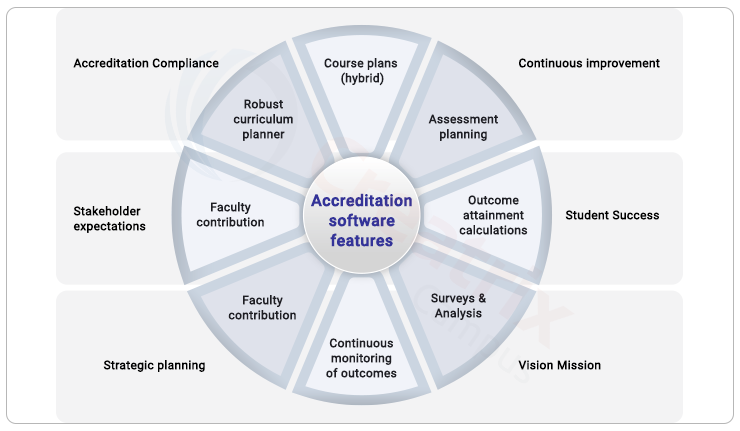
Conclusion - How Creatrix Accreditation Software can help HEIs in NCAAA
For an institution to get National Commission for Academic Accreditation and Assessment (NCAAA) accredited in Saudi Arabia is a massive threshold of recognition, increased credibility, improved student outcomes, better facilitation of transfer and articulation, and better access to funding, partnerships, and programs.
The manual way of chasing things can be challenging for higher education institutions, as it requires a significant investment of time, resources, and effort. Do not worry, we do the weightlifting for you at Creatrix.
Institutions can rely on Creatrix Accreditation automation software that helps streamline and standardize the data collection, analysis, and reporting processes involved in accreditation and assessment. By using accreditation software like Creatrix, the NCAAA process can go without the risk of manual errors and missing! The software can add efficiency to the whole self-study report and SER submission.
Creatrix Accreditation platform is fair, transparent, and easy to use and is built to maintain the integrity of the accreditation and assessment processes. It is completely secured and comes bundled with all safety compliances and standards so your data remind safe in our cloud-based environment. Try talking to our accreditation experts and see on a live demo how our system automates your NCAAA process.



